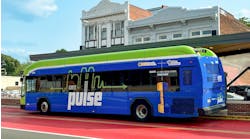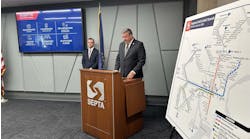Fare collection updates: SacRT, Valley Metro, King County Metro
The Sacramento Regional Transit District (SacRT), Valley Metro and King County Metro Transit are making fare adjustments.
SacRT implements contactless payment
On April 1, SacRT is introducing Tap2Ride, a contactless fare payment system on all buses and SacRT GO paratransit service vehicles.
With Tap2Ride, SacRT says riders can use their contactless debit or credit cards or mobile wallets to quickly and securely pay their fare when boarding, eliminating the need for cash or paper tickets. According to the agency, cash, along with all other current forms of valid fare, will continue to be accepted.
“SacRT is committed to making transit easier and more accessible for everyone,” said SacRT General Manager and CEO Henry Li. “Tap2Ride is a major step forward in modernizing our fare payment system, giving riders the speed and convenience they expect while improving efficiency across our network.”
SacRT notes Tap2Ride will be launched in two phases. Phase 1 starts on April 1 and will allow riders to tap their contactless Visa or Mastercard credit/debit card or mobile wallet (smartphone or watch) on Tap2Ride devices installed on all SacRT vehicles. According to SacRT, Phase 1 of the Tap2Ride program offers riders the benefits of daily fare capping and 90-minute free transfers between bus routes similar to Connect Card.
The agency notes riders tap their contactless payment option to the device upon boarding the bus, and the Tap2Ride system will select the best fare (single ride or daily pass) based on their travel for the day. SacRT says riders can also continue to use contactless payment at light-rail station vending machines. During Phase 1, SacRT notes fare transfer benefits between bus and light rail will not be available when using Tap2Ride.
Phase 2 will launch in late 2025 and will allow riders to transfer seamlessly between buses and light rail using the same contactless payment method, with transfer benefits applied automatically.
According to SacRT, eligible riders can receive a 50 percent discount on basic fares through Tap2Ride. The agency notes discounts are securely linked to a rider’s contactless payment card through the California Integrated Travel Project (Cal-ITP) web tool, allowing for automatic fare reductions without the need for in-person verification.
“Cal-ITP is proud to partner with SacRT in making transit fare payments more convenient and accessible,” said Gillian Gillet, chief of data and digital services division for Caltrans and program manager of California Integrated Mobility. “This system enhances mobility by offering a secure, seamless way for riders to pay while ensuring those who qualify for discounts receive them automatically.”
"Digital ID is an important component of smarter and better-connected public services,” said State Chief Information Officer and Director of the California Department of Technology Liana Bailey-Crimmins. “California’s Digital ID Framework is making it easier for riders to access the benefits they’re entitled to—no paperwork and no hassle—just a giant step toward a future where digital services make life easier for everyone.”
SaCRT notes all current payment methods are still available to riders and that the Tap2Ride program is another option to pay for fares.
Valley Metro brings fare machines to streetcar stops
Valley Metro is currently installing fare machines at streetcar stops. The agency notes the free fare period for the streetcar will end later this year, with an official start date to be announced. Since opening streetcar service in 2022, the agency says there has always been a plan to introduce fares, as the revenue from fares will help support the operations of the streetcar and provide reliable and efficient service.
The agency notes streetcar fares will be integrated into its overall fare system. According to Valley Metro, riders will be able to pay using their Copper cards, mobile fare and buy a 1-ride fare at machines at each stop. The agency says reduced fares will also be an option for those who qualify.
King County Metro resumes fare enforcement
Starting March 31, King County Metro Transit will ask riders for proof of fare payment on buses and streetcars. The agency notes friendly, verbal reminders will be given to riders who did not pay and its first focus fare inspections will be on RapidRide routes, other high-ridership bus routes and the Seattle Streetcar.
“[King County] Metro relies on fares to provide safe, clean and reliable transit service; however, we estimate that one-third or more of our riders are not paying their fare,” said King County Metro Chief Safety Officer Rebecca Frankhauser. “By restarting fare enforcement, we’re confident that many of our riders will return to their habits of tapping their ORCA cards or paying at the farebox.”
The agency will deploy 30 fare enforcement officers across the system from among the ranks of 175 transit security officers. King County Metro paused fare enforcement in 2020 to reassess and reimagine safety, security and fare enforcement to make the transit system more equitable and welcoming. The agency says it currently provides more than 300,000 rides each weekday and 2024 bus ridership was about 90 million systemwide. According to King County Metro, fares accounted for an estimated $73 million in revenue in 2024.
The agency’s adult fare is currently $2.75. Beginning March 31, fare enforcement officers will accept proof of payment in the form of:
- A recently tapped ORCA fare card.
- An activated Transit GO Ticket on their phone.
- A tapped ORCA card in Google Wallet.
- A transfer slip issued to someone who paid cash at the farebox.
King County Metro notes many regional businesses provide their employees with ORCA cards. The agency says employees who receive cards from their employers are still required to tap their cards and show proof of payment if asked by a fare enforcement officer.
King County Metro notes riders who do not have valid proof of payment will receive a written warning. Riders will receive two of the written warnings without consequence. The agency says third and subsequent citations may result in a fine or an alternative resolution.
For third and subsequent violations, the agency says rider may choose from the following:
- Pay a fine of $40 within 90 days, reduced to $20 within 30 days.
- Load $20 onto an ORCA card or—if eligible—$10 onto a reduced fare program card.
- Enroll in a reduced fare program if eligible.
- Perform two hours of community service.
- Appeal to the fare adjudication program manager or request a customized resolution.
The agency notes that youth who do not have proof of payment will not face a fine or alternative resolution and will instead receive information on how to enroll in the Free Youth Transit Pass.
King County Metro says its Safety, Security and Fare Enforcement (SaFE) Equity Workgroup led the redesign of fare inspection. Some of the improvements include:
- More affordable fines
- More forgiving policies regarding late payments
- Lower minimum amounts to load on ORCA or ORCA LIFT cards for riders pursuing one of the alternative resolution options
The agency notes the workgroup also made important recommendations on communications strategy, community outreach, messaging, tone and visuals.

Brandon Lewis | Associate Editor
Brandon Lewis is a recent graduate of Kent State University with a bachelor’s degree in journalism. Lewis is a former freelance editorial assistant at Vehicle Service Pros in Endeavor Business Media’s Vehicle Repair Group. Lewis brings his knowledge of web managing, copyediting and SEO practices to Mass Transit Magazine as an associate editor. He is also a co-host of the Infrastructure Technology Podcast.







